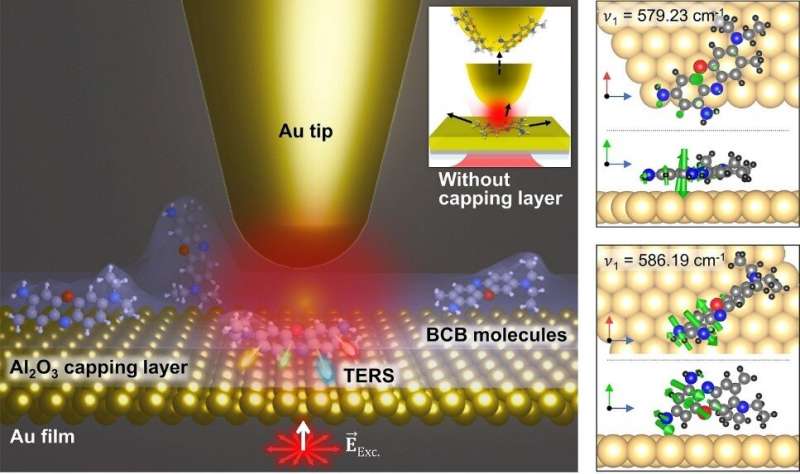Observing the difference in structural dynamics of 1 nm single-molecules at room temperature for the first time

Chemists' long-held dream of observing the structural dynamics of a single molecule have been now been made possible. Single molecules sized about 1 nanometer exist in a volatile state under ambient conditions. Considering that the coronavirus, which is about 100 nm in size, spreads rapidly in the air shows how difficult it is to observe a single molecule. Recently, a Korean research team has discovered a reliable way to observe single molecules at room temperature by capping them with a thin insulating layer, like a blanket.
The research team led by Professor Kyoung-Duck Park and Ph.D. candidate Mingu Kang (Department of Physics) at POSTECH, in collaboration with Professor Yung Doug Suh (Department of Chemistry) at Ulsan National Institute of Science and Technology (UNIST), has successfully probed the conformation (arrangement of the atoms in a molecule) of individual molecules at room temperature for the first time, providing a closer look at the structural dynamics of a single molecule, which is the basic unit of all matters including humans.
In-depth analysis using Raman scattering signals, known as the molecular "fingerprint," is difficult for molecules exposed to air due to the continuous chemical reactions and molecular motions. Extremely low temperature (below -200 °C) and vacuum conditions have been widely used for the single-molecule studies to prevent the aforementioned issues, yet the configurations have many limitations in terms of technical difficulties and environmental conditions.
To overcome this, the research team placed a single molecule on a substrate coated with a thin film of gold and covered it with a very thin layer of aluminum oxide (Al2O3). The molecule trapped between the gold and aluminum oxide layers is isolated from its surroundings, which lead to suppressed chemical reactions and molecular motions.
The immobilized molecule is then observed through the ultrasensitive tip-enhanced nanoscopy developed by the research team. Using the method allows for the precise detection of weak optical signals of a single molecule, owing to the optical antenna effect of the sharp metal tip. Through this, the resolution limit of a general optical microscopy (approximately 500 nm) was overcome to clearly distinguish the conformational heterogeneity of 1 nm-sized single-molecules and verify whether they are standing vertically or laying horizontally.
Mingu Kang of POSTECH says that "whilst the James Webb Space Telescope can observe the farthest point of the observable universe to reveal the universe's origin, our nanoscopy for single-molecules observes the smallest unit to reveal the origin of life."
The work can reveal the molecular conformation of proteins and DNA with a nanometer-level resolution, which leads to the identification of the cause of incurable diseases and the development of treatments for such conditions. Additionally, covering a sample with a thin layer can be easily applied at room temperature or even higher temperatures for single-molecule studies and their applications.
The study was recently published in Nature Communications.
More information: Mingu Kang et al, Conformational heterogeneity of molecules physisorbed on a gold surface at room temperature, Nature Communications (2022). DOI: 10.1038/s41467-022-31576-x
Journal information: Nature Communications
Provided by Pohang University of Science & Technology (POSTECH)





















